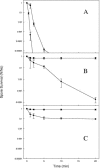Survival of spacecraft-associated microorganisms under simulated martian UV irradiation
- PMID: 16332797
- PMCID: PMC1317311
- DOI: 10.1128/AEM.71.12.8147-8156.2005
Survival of spacecraft-associated microorganisms under simulated martian UV irradiation
Abstract
Spore-forming microbes recovered from spacecraft surfaces and assembly facilities were exposed to simulated Martian UV irradiation. The effects of UVA (315 to 400 nm), UVA+B (280 to 400 nm), and the full UV spectrum (200 to 400 nm) on the survival of microorganisms were studied at UV intensities expected to strike the surfaces of Mars. Microbial species isolated from the surfaces of several spacecraft, including Mars Odyssey, X-2000 (avionics), and the International Space Station, and their assembly facilities were identified using 16S rRNA gene sequencing. Forty-three Bacillus spore lines were screened, and 19 isolates showed resistance to UVC irradiation (200 to 280 nm) after exposure to 1,000 J m(-2) of UVC irradiation at 254 nm using a low-pressure mercury lamp. Spores of Bacillus species isolated from spacecraft-associated surfaces were more resistant than a standard dosimetric strain, Bacillus subtilis 168. In addition, the exposure time required for UVA+B irradiation to reduce the viable spore numbers by 90% was 35-fold longer than the exposure time required for the full UV spectrum to do this, confirming that UVC is the primary biocidal bandwidth. Among the Bacillus species tested, spores of a Bacillus pumilus strain showed the greatest resistance to all three UV bandwidths, as well as the total spectrum. The resistance to simulated Mars UV irradiation was strain specific; B. pumilus SAFR-032 exhibited greater resistance than all other strains tested. The isolation of organisms like B. pumilus SAFR-032 and the greater survival of this organism (sixfold) than of the standard dosimetric strains should be considered when the sanitation capabilities of UV irradiation are determined.
Figures







References
-
- Anonymous. 1989. Contamination control procedure for the tape lift sampling of surfaces. Jet Propulsion Laboratory communication GSFC-TLS-PR-7324-01. National Aeronautics and Space Administration, Washington, D.C.
-
- Anonymous. 1980. NASA standard procedures for the microbiological examination of space hardware. Jet Propulsion Laboratory communication NHB 5340.1B. National Aeronautics and Space Administration, Washington, D.C.
-
- Appelbaum, J., and D. J. Flood. 1990. Solar radiation on Mars. Sol. Energy 45:353-363.
-
- Arvidson, R., R. Anderson, P. Bartlett, J. Bell, P. Christensen, P. Chu, K. Davis, B. Ehlmann, M. Golombek, S. Gorevan, E. Guinness, A. Haldemann, K. Herkenhoff, G. Landis, R. Li, R. Lindemann, D. Ming, T. Myrick, T. Parker, L. Richter, F. Seelos, L. Soderblom, S. Squyres, R. Sullivan, and J. Wilson. 2004. Localization and physical property experiments conducted by opportunity at Meridiani Planum. Science 306:1730-1733. - PubMed
-
- Betancourt, W. Q., and J. B. Rose. 2004. Drinking water treatment processes for removal of Cryptosporidium and Giardia. Vet. Parasitol. 126:219-234. - PubMed
Publication types
MeSH terms
LinkOut - more resources
Full Text Sources
Other Literature Sources
Molecular Biology Databases
Miscellaneous

